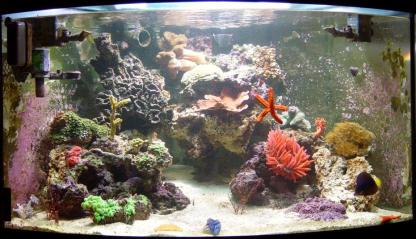 Tank
Tank
This tank does not have an overflow chamber and sump. That makes it simpler (and reduces dangers from power failures), but in hindsight I think it's a mistake. The water surface isn't as clean as could be, and the equipment (heater, skimmer) needs to be in the tank itself. I placed all that behind the live rocks, so it isn't a major issue. Still, it would be nice to do water changes in the sump instead of disturbing the animals.
I had a skimmer failure (and lost some livestock) after nine months, because the pump got clogged. With the live rock, it's hard to take the skimmer out. It was also hard to tell (in time) that it had failed, because the pump was still partially working, just not enough to clean the water.
I originally pointed the pumps into the center of the tank, but the surface (without an overflow!) quickly became filmy. To break it up and encourage gas exchange, most pumps now point at the surface. The pump intakes provide much of the full-tank circulation.
For awhile I had a Rio behind my live rocks at sand level in the back, on the theory of eliminating stagnant pools. I'd stop the pumps during water changes, but Rios often have trouble restarting. It was too hard to maintain under the rocks.
For some extra in-tank turbulence, I installed the MJ600, aimed straight in the middle of the tank. This isn't bad, but a better arrangement would have varying currents, say by turning pumps on and off, or a SCWD with plumbing to alternate the water flow.
My tank came with 65x2 watts of PC lighting, but I almost immediately swapped it out for a MH hood, knowing that I wanted to keep demanding photosynthetic corals. One problem with the tank is that the top is pie-shaped, but basically all light hoods are rectangular. This makes the corners a bit darker than ideal.
I haven't figured out a good way to mount the light hood. I could hang it from the ceiling, but I'd want it low most of the time, and then somehow out of the way for feeding or maintenance. For now, it's just sitting on the glass top of the tank. The hood gets hot with the MH light, so I raised it by putting 1-inch marble blocks under the corners of the hood. Hopefully, this will help with heat into the tank. (The hood also has a fan that blows air out to the side.)
I originally had the lights on 14 hrs (MH for 12). This served as a nice evening night light in the house. After persistent brown algae growth on my sand surface, it was recommended that I reduce the light period. I did, and the algae problem seems better.
It's kind of a meaningless statistic, but this setup (300+ watts of light, 50+ gallon tank) makes for about 6 watts/gallon, which is in the middle of recommended high-end lighting (5-8 watts/gallon) for demanding reef tanks.
OtherMy heater is OK, although the marked temperature settings don't seem to correspond to the tank temperature. Ideally, I'd have a sump, and two different half-power heaters (so that if one failed, the other would still work). For now, this works fine. There is no chiller, though, and in the summer the temperature often reaches 82 or even 84.
The tank has a glass cover on top, which basically prevents evaporation. This means that I never (!) need to add top-off fresh water. But it also means that I can't use the evaporation for cooling. The reduced maintenance is compelling, though.
| webmaster@geddis.org | reef.geddis.org | Last updated 08/19/06 |